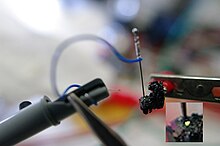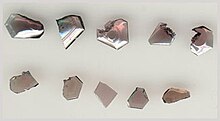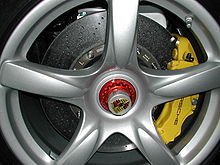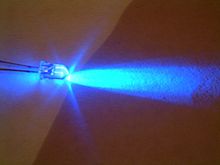Silicon carbide
From Wikipedia, the free encyclopedia
| Silicon carbide | |
|---|---|
 | |
| Identifiers | |
| CAS number | 409-21-2 |
| PubChem | 9863 |
| ChemSpider | 9479 |
| EC number | 206-991-8 |
| MeSH | Silicon+carbide |
| ChEBI | CHEBI:29390 |
| RTECS number | VW0450000 |
| Gmelin Reference | 13642 |
| Jmol-3D images | Image 1 |
| Properties | |
| Molecular formula | CSi |
| Molar mass | 40.1 g mol−1 |
| Exact mass | 39.976926533 g mol−1 |
| Appearance | Colorless crystals |
| Density | 3.21 g/cm3 (all polytypes) [1] |
| Melting point | 2730 °C, 3003 K, 4946 °F (decomposes) |
| Electron mobility | ~900 cm2/(V·s) (all polytypes) |
| Refractive index(nD) | 2.55 (infrared; all polytypes) [2] |
| Hazards | |
| EU classification | not listed |
| NFPA 704 | |
| Except where noted otherwise, data are given for materials in their standard state (at 25 °C, 100 kPa) | |
| Infobox references | |
Silicon carbide (SiC), also known as carborundum, is a compound of silicon and carbon with chemical formula SiC. It occurs in nature as the extremely rare mineral moissanite. Silicon carbide powder has been mass-produced since 1893 for use as an abrasive. Grains of silicon carbide can be bonded together by sintering to form very hard ceramics which are widely used in applications requiring high endurance, such as car brakes, car clutches and ceramic plates in bulletproof vests. Electronic applications of silicon carbide as light emitting diodes (LEDs) and detectors in early radios were first demonstrated around 1907, and nowadays SiC is widely used in high-temperature/high-voltage semiconductor electronics. Large single crystals of silicon carbide can be grown by the Lely method; they can be cut into gems known as "synthetic moissanite". Silicon carbide with high surface area can be produced from SiO2 contained in plant material.
 [edit]Discovery and early production
[edit]Discovery and early production
Early, non-systematic and often non-recognized syntheses of silicon carbide had been reported by Despretz (1849), Marsden (1880) and Colson (1882).[3] Wide-scale production is credited toEdward Goodrich Acheson around 1893. He patented the method for making silicon carbide powder on February 28, 1893.[4] Acheson also developed the electric batch furnace by which SiC is still made today and formed The Carborundum Company to manufacture bulk SiC, initially for use as an abrasive.[5] In 1900 the company settled with the Electric Smelting and Aluminum Company when a judge's decision gave "priority broadly" to its founders "for reducing ores and other substances by the incandescent method".[6] It is said that Acheson was trying to dissolve carbon in molten corundum (alumina) and discovered the presence of hard, blue-black crystals which he believed to be a compound of carbon and corundum: hence carborundum. Or, he named the material "carborundum" by analogy to corundum, which is another very hard substance (9 on the Mohs scale).
Historically, the first use of SiC was as an abrasive. This was followed by electronic applications. In the beginning of the 20th century, silicon carbide was used as a detector in the first radios,[7] and in 1907 Henry Joseph Round produced the first LED by applying a voltage to a SiC crystal and observing yellow, green and orange emission at the cathode. Those experiments were later repeated by O. V. Losev in the Soviet Union in 1923.[8]
[edit]Natural occurrence
Naturally occurring moissanite is found only in minute quantities in certain types of meteorite and in corundum deposits and kimberlite. Virtually all the silicon carbide sold in the world, including moissanite jewels, is synthetic. Natural moissanite was first found in 1893 as a small component of the Canyon Diablo meteorite in Arizona by Dr. Ferdinand Henri Moissan, after whom the material was named in 1905.[9]Moissan's discovery of naturally occurring SiC was initially disputed because his sample may have been contaminated by silicon carbide saw blades that were already on the market at that time.[10]
While rare on Earth, silicon carbide is remarkably common in space. It is a common form of stardust found around carbon-rich stars, and examples of this stardust have been found in pristine condition in primitive (unaltered) meteorites. The silicon carbide found in space and in meteorites is almost exclusively the beta-polymorph. Analysis of SiC grains found in the Murchison carbonaceous chondrite meteorite has revealed anomalous isotopic ratios of carbon and silicon, indicating an origin from outside the solar system; 99% of these SiC grains originate around carbon-rich asymptotic giant branch stars.[11] SiC is commonly found around these stars as deduced from their infrared spectra.[12]
[edit]Production
Due to the rarity of natural moissanite, silicon carbide is typically man-made. Most often it is used as an abrasive, and more recently as asemiconductor and diamond simulant of gem quality. The simplest manufacturing process is to combine silica sand and carbon in an Acheson graphite electric resistance furnace at a high temperature, between 1600 and 2500 °C. Fine SiO2 particles in plant material (e.g. rice husks) can be converted to SiC by heating in the excess carbon from the organic material.[13]
The material formed in the Acheson furnace varies in purity, according to its distance from the graphite resistor heat source. Colorless, pale yellow and green crystals have the highest purity and are found closest to the resistor. The color changes to blue and black at greater distance from the resistor, and these darker crystals are less pure. Nitrogen and aluminium are common impurities, and they affect the electrical conductivity of SiC.[14]
Pure silicon carbide can be made by the so-called Lely process,[15] in which SiC powder is sublimated in argon atmosphere at 2500 °C and redeposited into flake-like single crystals[1], sized up to 2×2 cm2, at a slightly colder substrate. This process yields high-quality single crystals, mostly of 6H-SiC phase (because of high growth temperature). A modified Lely process involving induction heating in graphitecrucibles yields even larger single crystals of 4 inches (10 cm) in diameter, having a section 81 times larger compared to the conventional Lely process.[16] Cubic SiC is usually grown by the more expensive process of chemical vapor deposition (CVD).[14][17] Pure silicon carbide can also be prepared by the thermal decomposition of a polymer, poly(methylsilyne), under an inert atmosphere at low temperatures. Relative to the CVD process, the pyrolysis method is advantageous because the polymer can be formed into various shapes prior to thermalization into the ceramic.[18][19][20][21]
[edit]Structure and properties
Main article: Polymorphs of silicon carbide
- Structure of major SiC polytypes.
Silicon carbide exists in about 250 crystalline forms.[22] The polymorphism of SiC is characterized by a large family of similar crystalline structures called polytypes. They are variations of the same chemical compound that are identical in two dimensions and differ in the third. Thus, they can be viewed as layers stacked in a certain sequence.[23]
Alpha silicon carbide (α-SiC) is the most commonly encountered polymorph; it is formed at temperatures greater than 1700 °C and has a hexagonal crystal structure (similar to Wurtzite). The beta modification (β-SiC), with a zinc blende crystal structure (similar to diamond), is formed at temperatures below 1700 °C.[24] Until recently, the beta form has had relatively few commercial uses, although there is now increasing interest in its use as a support for heterogeneous catalysts, owing to its higher surface area compared to the alpha form.
| Polytype | 3C (β) | 4H | 6H (α) |
|---|---|---|---|
| Crystal structure | Zinc blende (cubic) | Hexagonal | Hexagonal |
| Space group | T2d-F43m | C46v-P63mc | C46v-P63mc |
| Pearson symbol | cF8 | hP8 | hP12 |
| Lattice constants (Å) | 4.3596 | 3.0730; 10.053 | 3.0730; 15.11 |
| Density (g/cm3) | 3.21 | 3.21 | 3.21 |
| Bandgap (eV) | 2.36 | 3.23 | 3.05 |
| Bulk modulus (GPa) | 250 | 220 | 220 |
| Thermal conductivity (W/(cm·K)) | 3.6 | 3.7 | 4.9 |
Pure SiC is colorless. The brown to black color of industrial product results from iron impurities. The rainbow-like luster of the crystals is caused by a passivation layer of silicon dioxide that forms on the surface.
The high sublimation temperature of SiC (approximately 2700 °C) makes it useful for bearingsand furnace parts. Silicon carbide does not melt at any known pressure. It is also highly inert chemically. There is currently much interest in its use as a semiconductor material in electronics, where its high thermal conductivity, high electric field breakdown strength and high maximum current density make it more promising than silicon for high-powered devices.[25] SiC also has a very low coefficient of thermal expansion (4.0 × 10−6/K) and experiences no phase transitions that would cause discontinuities in thermal expansion.[14]
[edit]Electrical conductivity
Silicon carbide is a semiconductor, which can be doped n-type by nitrogen or phosphorus and p-type by aluminium, boron, gallium or beryllium.[2] Metallic conductivity has been achieved by heavy doping with boron, aluminium or nitrogen. Superconductivity has been detected in 3C-SiC:Al, 3C-SiC:B and 6H-SiC:B at the same temperature of 1.5 K.[26] or aluminum.[24] A crucial difference is however observed for the magnetic field behavior between aluminum and boron doping: SiC:Al is type-II, same as Si:B. On the contrary, SiC:B is type-I. In attempt to explain this difference, it was noted that Si sites are more important than carbon sites for superconductivity in SiC. Whereas boron substitutes carbon in SiC, Al substitutes Si sites. Therefore, Al and B "see" different environment that might explain different properties of SiC:Al and SiC:B.[27]
[edit]Uses
[edit]Abrasive and cutting tools
In the arts, silicon carbide is a popular abrasive in modern lapidary due to the durability and low cost of the material. In manufacturing, it is used for its hardness in abrasive machining processes such as grinding, honing, water-jet cutting and sandblasting. Particles of silicon carbide are laminated to paper to create sandpapers and the grip tape on skateboards.[28]
In 1982 an exceptionally strong composite of aluminium oxide and silicon carbide whiskers was discovered. Development of this laboratory-produced composite to a commercial product took only three years. In 1985, the first commercial cutting tools made from this alumina and silicon carbide whisker-reinforced composite were introduced by the Advanced Composite Materials Corporation (ACMC) and Greenleaf Corporation.[29]
[edit]Structural material
In the 1980s and 1990s, silicon carbide was studied in several research programs for high-temperature gas turbines in Europe, Japan and the United States. The components were intended to replace nickel superalloy turbine blades or nozzle vanes. However, none of these projects resulted in a production quantity, mainly because of its low impact resistance and its low fracture toughness.[30]
Like other hard ceramics (namely alumina and boron carbide), silicon carbide is used in composite armor (e.g., Chobham armor), and in ceramic plates in bulletproof vests. Dragon Skin, which is produced by Pinnacle Armor, uses disks of silicon carbide.[31]
[edit]Automobile parts
Silicon-infiltrated carbon-carbon composite is used for high performance "ceramic" brake discs as it is able to withstand extreme temperatures. The silicon reacts with the graphite in the carbon-carbon composite to become carbon fiber reinforced silicon carbide (C/SiC). These discs are used on some road going sports cars, including the Porsche Carrera GT, the Bugatti Veyron, the Chevrolet Corvette ZR1, Bentleys, Ferraris, Lamborghinis, and some specific high performance Audis.[32]Silicon carbide is also used in a sintered form for diesel particulate filters.[33]
[edit]Electric systems
The earliest electrical application of SiC was in lightning arresters in electric power systems. These devices must exhibit high resistance until the voltage across them reaches a certain threshold VT, at which point their resistance must drop to a lower level and maintain this level until the applied voltage drops below VT.[34]
It was recognized early on that SiC had such a voltage-dependent resistance, and so columns of SiC pellets were connected between high-voltage power lines and the earth. When a lightning strike to the line raises the line voltage sufficiently, the SiC column will conduct, allowing strike current to pass harmlessly to the earth instead of along the power line. Such SiC columns proved to conduct significantly at normal power-line operating voltages and thus had to be placed in series with a spark gap. This spark gap is ionized and rendered conductive when lightning raises the voltage of the power line conductor, thus effectively connecting the SiC column between the power conductor and the earth. Spark gaps used in lightning arresters are unreliable, either failing to strike an arc when needed or failing to turn off afterwards, in the latter case due to material failure or contamination by dust or salt. Usage of SiC columns was originally intended to eliminate the need for the spark gap in a lightning arrester. Gapped SiC lightning arresters were used as lightning-protection tool and sold under GE and Westinghouse brand names, among others. The gapped SiC arrester has been largely displaced by no-gap varistors that use columns ofzinc oxide pellets.[35]
[edit]Electronic circuit elements
Silicon carbide is used for ultrafast, high-voltage Schottky diodes, MOSFETs and high temperature thyristors for high-power switching.[25] A major problem for SiC commercialization has been the elimination of defects edge dislocations, screw dislocations (both hollow and closed core), triangular defects and basal plane dislocations.[36] As a result, devices made of SiC crystals initially displayed poor reverse blocking performance though researchers have been tentatively finding solutions to improving the breakdown performance.[37] Apart from crystal quality, problems with the interface of SiC with silicon dioxide have hampered the development of SiC-based power MOSFETs and insulated-gate bipolar transistors.
The history of SiC LEDs is quite remarkable: the first LED action was demonstrated in 1907 using SiC and the first commercial LEDs were again based on SiC. Yellow LEDs made from 3C-SiC were manufactured in the Soviet Union in the 1970s,[38] and blue ones (6H-SiC) worldwide in the 1980s.[39] The production was soon stopped because gallium nitride showed 10–100 times brighter emission. This difference in efficiency is due to the unfavorable indirect bandgap of SiC whereas GaN has a direct bandgap which favors light emission. However, SiC is still one of the important LED components – it is a popular substrate for growing GaN devices, and it also serves as a heat spreader in high-power LEDs.[39]
[edit]Astronomy
The low thermal expansion coefficient, high hardness, rigidity and thermal conductivity make silicon carbide a desirable mirror material for astronomical telescopes. The growth technology (chemical vapor deposition) has been scaled up to produce disks of polycrystalline silicon carbide up to 3.5 meters in diameter, and several telescopes (like the Herschel Space Telescope) are already equipped with SiC optics.[40][41]
[edit]Thin filament pyrometry
Main article: Thin filament pyrometry
Silicon carbide fibers are used to measure gas temperatures in an optical technique called thin filament pyrometry. It involves the placement of a thin filament in a hot gas stream. Radiative emissions from the filament can be correlated with filament temperature. Filaments are SiC fibers with a diameter of 15 micrometers, that is about 5 times thinner than human hair. Because the fibers are so thin, they do little to disturb the flame and their temperature remains close to that of the local gas. Temperatures of about 800–2500 K can be measured.[42][43]
[edit]Heating elements
References to silicon carbide heating elements exist from the early 20th century when they were produced by Acheson's Carborundum Co. in the U.S. and EKL in Berlin. Silicon carbide offered increased operating temperatures compared with metallic heaters. Silicon carbide elements are used today in the melting of non-ferrous metals and glasses, heat treatment of metals, float glass production, production of ceramics and electronics components, igniters in pilot lights for gas heaters, etc.[44]
[edit]Nuclear fuel particles
Silicon carbide is an important material in TRISO-coated fuel particles, the type of nuclear fuel found in high temperature gas cooled reactors(such as the Pebble Bed Reactor). A layer of silicon carbide gives coated fuel particles structural support and is the main diffusion barrier to the release of fission products.[45]
[edit]Jewelry
As a gemstone used in jewelry, silicon carbide is called "synthetic moissanite" or just "moissanite" after the mineral name. Moissanite is similar to diamond in several important respects: it is transparent and hard (9-9.5) on the Mohs scale (compared to 10 for diamond), with a refractive indexbetween 2.65 and 2.69 (compared to 2.42 for diamond). Moissanite is somewhat harder than commoncubic zirconia. Unlike diamond, moissanite can be strongly birefringent. This quality is desirable in some optical applications, but not in gemstones. For this reason, moissanite jewels are cut along theoptic axis of the crystal to minimize birefringent effects. It is lighter (density 3.21 g/cm3 vs. 3.53 g/cm3), and much more resistant to heat than diamond. This results in a stone of higher luster, sharper facets and good resilience. Loose moissanite stones may be placed directly into wax ring moulds for lost-wax casting; unlike diamond, which burns at 800 °C, moissanite remains undamaged by temperatures up to 1800 °C. Moissanite has become popular as a diamond substitute, and may be misidentified as diamond, since its thermal conductivity is much closer to that of diamond than any other diamond substitute. Many thermal diamond testing devices are fooled by moissanite, but the gem can be distinguished from diamond by its birefringence and a very slight green or yellow fluorescence under ultraviolet light. Some moissanite stones also have curved string-like inclusions, which diamonds never have.[46]
[edit]Steel production
Silicon carbide dissolved in a basic oxygen furnace used for making steel acts as a fuel. It is cleaner than coal, allowing a reduction in scrap output. It can also be used to raise tap temperatures and adjust the carbon content. Silicon carbide is cheaper than of a combination offerrosilicon and carbon, produces cleaner steel due to low level of trace elements, has a low gas content, and does not lower the temperature of steel.[47]
[edit]Catalyst support
The natural resistance to oxidation exhibited by silicon carbide, as well as the discovery of new ways to synthesize the cubic β-SiC form, with its larger surface area, has led to significant interest in its use as a heterogeneous catalyst support. This form has already been employed as a catalyst support for the oxidation of hydrocarbons, such as n-butane, to maleic anhydride.[48][49]
[edit]Carborundum printmaking
Silicon carbide is used in carborundum printmaking – a collagraph printmaking technique. Carborundum grit is applied in a paste to the surface of an aluminium plate. When the paste is dry, ink is applied and trapped in its granular surface, then wiped from the bare areas of the plate. The ink plate is then printed onto paper in a rolling-bed press used for intaglio printmaking. The result is a print of painted marks embossed into the paper.[50]
[edit]Graphene production
Silicon carbide is used to produce graphene by graphitization at high temperatures. This is considered as one of the promising methods to synthesize graphene at large scale for practical applications.[51][52]













If you are looking for buy car accessories online.I think this place provide any kind of car accessories to get at affordable price.
ReplyDeleteVolkswagen Clutch repair & Volvo Clutch repair